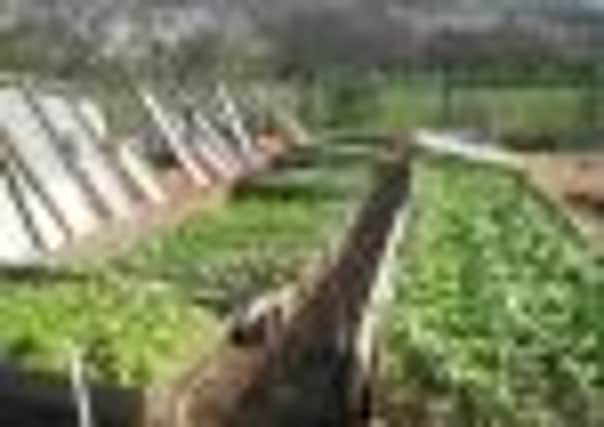Gardening: Beat the frost for early crops with techniques in use since Roman times


But make your way to Jack First’s garden in Yorkshire and you’ll find a rather different picture. He’s currently got spinach, salad leaves and lettuces coming through, from a sowing made a week before Christmas. How does he manage it? By using hot beds.
Early crops are something of a rarity in British gardens. The cold, wet soils we encounter from January to April mean that sowing has to wait for warmer conditions and in spring and early summer there’s every chance of further rain and cool weather to contend with. First says this is a real shame, because after 21 December daylight gradually lengthens, and light is a major stimulus to plant growth. So how do we pre-warm the soil and protect young plants? This is where hot beds come in. And far from being groundbreaking technology, it’s actually an ancient technique, enthusiastically adopted by the Romans, the Victorians and it seems to be long overdue a revival.
Advertisement
Hide AdAdvertisement
Hide Ad“The general public rely on just a few per cent of the population to produce food, but if more people grew some of their food then this technique would be more widely used, along with other lost arts,” says First. With increasing numbers of people seeing the value in growing their own fruit and vegetables, it seems that there is a ready-made audience for First’s new guide, a pocket book called Hot Beds. In it we discover the history, benefits and practicalities of setting up our own hot beds.
First points out that if you look at a stack of stable manure on a cold day, you see steam coming off it. This heat source was seized on by the Romans, particularly the gardeners of Tiberius (42BC-AD27), who demanded salads out of season. So they built beds of stable manure and placed frames on top. Soil was then put into the frame and it was covered with thin, translucent sheets. The manure warmed the soil and the air temperature inside the beds, giving the gardeners a head start with their growing. It is essentially this same technique we can utilise today.
The book contains full instructions on how to build a hot bed. The first question on most people’s minds might be: where do I source the required manure? “Check the Yellow Pages for your area and see how many stables or equestrian centres there are, and also stock farmers,” says First. “Check out how much manure they produce. There are, so I am told, over one million horses, ponies and donkeys in the UK. A horse produces 50 pounds of urine and droppings a day, not to mention the bedding.”
Some riding centres or farms will provide the manure for free if you can collect it, or they may charge a small delivery fee, so it’s worth doing your research. To fill a 6ft x 6ft x 3ft frame, you’d need about three to four cubic metres of manure. It sounds like a lot, but First says it’d only take two people with forks and barrows about an hour to move it.
If manure doesn’t sound right for you, alternatives can be used or combined to create your heat source. “There must be millions of tons of leaves blowing about our streets going to waste when they could be used to produce heat in a hot bed,” says First. “If garden waste or kitchen waste could be kept on the dry side instead of being composted, then here is another source.”
These free materials, along with inexpensive manure, mean that hot beds are a cost-effective alternative to greenhouses and polytunnels. The frame is light and cheap to make and the beds have the added benefit of being able to admit full sunlight and rainfall.
Once your hot bed is set up, it’s a question of deciding what to grow in it. Spinach, mixed lettuces, salad leaves, carrots and radishes are a few of the plants First highlights, while recommending all vegetables. Crops that are short in stature (as the roof of your beds will be on most of the time, to begin with) and fast-growing are ideal. In terms of maintenance, First says “it is better that people live close to their growing areas and during cold periods some insulation may be needed. Clearly, if one desires very early produce some extra work is required, but it is worth it.”
Other maintenance issues include extra watering in times of drought and paying close attention to ventilation, but First says “all maintenance tasks could be made easy by new technology such as irrigation and auto vents”.
Advertisement
Hide AdAdvertisement
Hide AdMany gardeners will have tried successional sowing and the same can be done with hot beds – starting trays or modules of plants off indoors so that the veg seedlings are ready to plant into the bed once your first crops are harvested. The beds can continue to be used for growing during summer when the heat has gone out of them and the spent manure makes a good garden mulch or can be used as a growing medium the following year. “The hot bed ultimately produces very rich compost,” says First. “Hot beds are good for wildlife. Hot beds produce hot water. All gardeners want to get out as soon as they can and you really can do this with hot beds.”
So if you fancy getting a head start on your salad crops, why not make this the year you join the hot bed revolution?
• Hot Beds by Jack First is published by Green Books (RRP £9.95, pb). Scotsman readers can buy it for £6.50 with free p&p (UK only) from greenbooks.co.uk/hot-beds; enter SCOTHOT in the promotion box; or tel: 0845 458 9910.